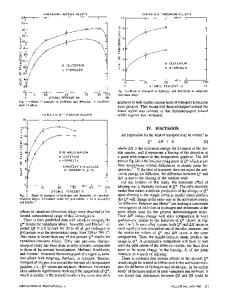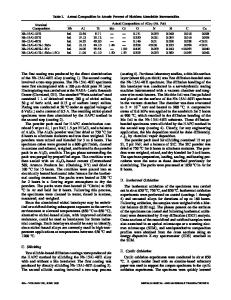Effect of Chromium and Niobium on the Kinetics of Synthesis of Titanium Aluminide
- PDF / 173,365 Bytes
- 7 Pages / 594 x 792 pts Page_size
- 33 Downloads / 328 Views
669.295.5:621.762
EFFECT OF CHROMIUM AND NIOBIUM ON THE KINETICS OF SYNTHESIS OF TITANIUM ALUMINIDE R. K. Gupta,1 Bhanu Pant,1 Vijaya Agarwala,2 and P. P. Sinha1 Translated from Metallovedenie i Termicheskaya Obrabotka Metallov, No. 8, pp. 39 – 45, August, 2013.
The kinetics of the reaction of synthesis of titanium aluminide from binary (Ti – 48% Al), ternary (Ti – 48% Al – 2% Cr, Ti – 48% Al – 2% Nb) and quaternary (Ti – 48% Al – 2% Cr – 2% Nb) mixtures of elementary powders is studied. Differential scanning calorimetry in heating of the powder mixtures is used to determine the temperature and heat of formation of titanium aluminides and the kinetic parameter and activation energy in the Johnson – Mehl – Avrami equation.
Key words: differential scanning calorimetry, titanium aluminides, reaction kinetics.
ferential scanning calorimetry are preferable because they give easily a large volume of experimental data. In these methods the tests are performed either in an isothermal mode or with a constant heating rate (a non-isothermal mode). The non-isothermal method is more suitable for studying such materials as titanium aluminides because it is hard to observe isothermal conditions in an exothermic reaction due to the emission of heat. The aim of the present work was to study the kinetics of the reaction of formation of titanium aluminide in binary (Ti – 48% Al), ternary (Ti – 48% Al – 2% Cr, Ti – 48% Al – 2% Nb), and quaternary (Ti – 48% Al – 2% Cr – 2% Nb)3 alloys using the non-isothermal method.
INTRODUCTION Titanium aluminides are important advanced materials for the aerospace and automotive industries due to their high-temperature properties and low density. Titanium aluminides are studied extensively and several processes have been suggested for their production. The process of self-propagating high-temperature synthesis has such advantages as a low loss of material, absence of segregations, use of cheaper elemental powders as compared to preliminarily alloyed powders, and possibility of formation of fine grains through the use of fine powders. The compound is formed by an exothermic reaction that occurs under specific conditions (temperature, atmosphere, etc.). It has been shown that a reaction of elemental powders of aluminum and titanium yields an aluminum-rich Al3Ti phase and Al2Ti and AlTi intermetallic phases at a certain content of retained elemental titanium [1 – 3]. The kinetics of the reaction of formation of the Al3Ti phase in the binary system has been studied in [4 – 13]. However, no data have been reported on the formation of titanium aluminides in the presence of additional alloying elements, i.e., chromium and niobium (individually or jointly), which constitute alloy systems important for applications. The reaction kinetics and the mechanism of self-propagating high-temperature synthesis of the reaction are studied by several methods [14 – 20]. The high-temperature thermoanalytical methods like differential thermal analysis and dif1 2
METHODS OF STUDY The powders of titanium (purity 99.5%, m
Data Loading...











